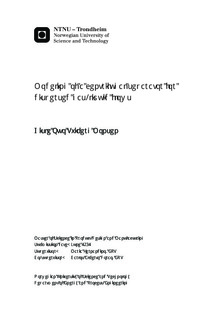Modeling of a centrifugal separator for dispersed gas-liquid flows
Master thesis
Permanent lenke
http://hdl.handle.net/11250/234799Utgivelsesdato
2012Metadata
Vis full innførselSamlinger
Sammendrag
Natural gas is a vital component of the worlds supply of energy. In Norway all the gas can be found offshore where it needs to processed before transport. A vital part of the processing is gas and liquid separation. Current gas-liquid separators are big and expensive, and the offshore industry is looking for more compact separators. One of the more prominent technologies is the NNNGLseparator developed at NTNU. To further identify its possibilities, a thorough research program has been startedIn this thesis one-dimensional models describing pressure drop and separation performance of the NTNU Natural Gas Liquid Separator (NNGLseparator) for dispersed gas-liquid flows has been studied. Here modeling of separation performance was divided into cyclonic separation and droplet capture by the meshpad, and then combined in sequence. The droplet capture is assumed to occur before cyclonic separation.To analyze the impact of centrifugal force on droplet capture, the force was included in a previous proposed model describing droplet capture by a single fiber in the meshpad. With this as basis, modeling of total droplet capture for the meshpad was analyzed. Through this analysis we proposed an extension on the existing model for the case of the flow not following the rotation of the meshpad. The droplets that are not captured are then separated through cyclonic separation. To model this separation mechanism, a modified time of flight model was developed. The modification includes the mesh porosity, and a - factor describing the droplet s reduced radial velocity due to the obstructing meshpad.Existing models for pressure drop across fixed porous media were compared to experimental data to identify which model best applies to the meshpad used in the NNGLseparator. How this model performs in describing a rotating porous media was then analyzed for the two scenarios; fully developed flow before mesh entry and developing flow inside a rotating meshpad. Through this analysis an extension to the pressure drop model was proposed, which includes the tangential velocity difference between rotating mesh and gas flow. A previous proposed model for pressure drop across wet mesh pad was reviewed. This led to a discussion on how liquid hold up differs in the NNGLseparator from conventional fixed meshpads. The proposed one-dimensional models were then analyzed through a parametric study of the separator performance in terms of pressure drop and efficiency of droplet separation for different flow conditions and geometries.
